Lecture
Didactics - Learning Theory
Essence, driving forces, contradictions and logic of the learning process
Learning functions
Patterns of the learning process
Principles of learning
Modern didactic concepts
Educational content
Different approaches to the design of educational content for students of different levels of education
State educational standards
Regulatory documents governing the content of general education
Variety of educational programs
Methods and techniques of learning
Classification of teaching methods
Means of education
Forms of study
The lesson as the main form of education in modern school
Typology and structure of lessons
The main forms of organization of educational and cognitive activity in the classroom
Additional forms of organization of the educational process
Student homework
Overtime work on the subject
Types and training systems
Classroom learning system
Lecture and seminar system of training
Variety of learning systems
Bell Lancaster Training System
Mannheim education system
Batavian training system
Project learning system
Dalton plan learning system
Brigade-laboratory learning system
Trump's plan learning system
Author's training systems
Didactic tools
Test questions and tasks
Materials for seminars
Complex test tasks
Updated teaching tools on external resources
Didactics - Learning Theory
The theory of learning (didactics) is traditionally considered as a relatively independent part of pedagogical science. Modern didactics is designed to implement the ideas of humane pedagogy, aimed at the formation of a free, creative, socially active, useful and successful person. Knowledge of the theory of learning is necessary for each teacher, since the tasks of education, upbringing and development of students in teaching activities are most effectively solved on the basis of scientific knowledge.
Didactics (from the Greek. Didaktikos - “teaching, teaching”) - the theory of learning.
Even in ancient Greece, a teacher who taught at school was called didaskal. The term "didactics" appeared in the XVII century. It was introduced by V. Ratke in the sense of the “art of learning”. Ya.A. Comenius in his book “The Great Didactics” defined didactics as “the universal art of teaching everything to everything,” including training and upbringing in the circle of issues studied by didactics. However, with the development of pedagogical science, didactics gradually focused its attention exclusively on the educational process.
Based on the definitions that are most recognized in educational science (Yu.K. Babansky, I.Ya. Lerner, IP Podlasyy, VI Zagvyazinsky), modern didactics can be defined as a relatively independent branch of pedagogy, a science that studies theoretical and methodological foundations of training, gives a scientific justification for the goals, content, methods, means, organization of training and education .
The subject of modern didactics is the interrelation and interaction of teaching (teaching and educating activity of a teacher) and teaching (educational and cognitive activity of students).
The main groups of tasks of modern didactics:
1) describe and explain the learning process and the conditions for its occurrence;
2) to improve the learning process, develop new, more effective learning systems and educational technologies.
Today, didactics covers various areas of research of the educational process :
- explores the nature and patterns of learning, the general principles of the organization of the educational process;
- studies and develops ways of enhancing students' cognitive activity;
- determines the pedagogical basis of the content of education;
- develops a system of methods, techniques and learning rules, determines the conditions for their effective use;
- develops and improves forms, types, systems, learning models;
- improves the organization of teaching and learning processes in various types of educational institutions.
To the top
Essence, driving forces, contradictions and logic of the learning process
Education is a process of joint purposeful activity of a teacher and students, in the course of which the education, upbringing and development of the personality is carried out (Fig. 4.1).
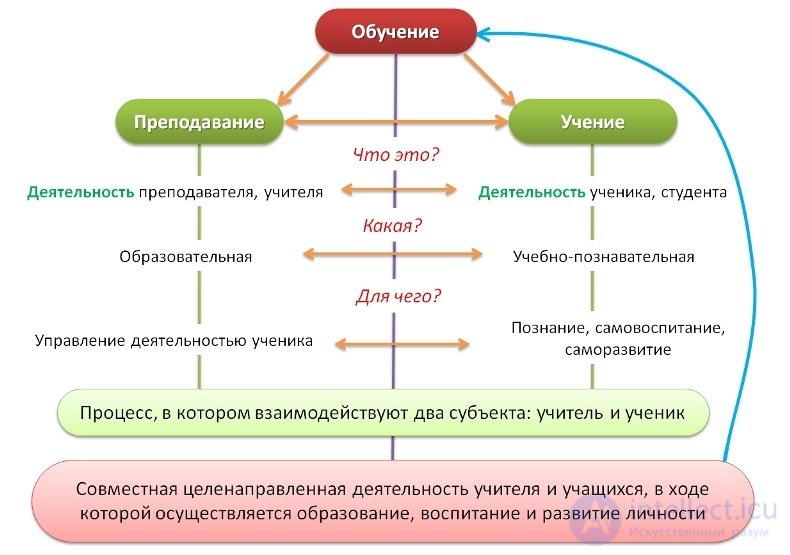
Fig. 4.1. The essence of the educational process
Training is a process, the flow of which is subject to a certain logic, which means that it can be studied, managed and predicted. The learning process is otherwise called the learning or didactic process.
The social orientation of learning is manifested in the fact that learning is one of the best ways of social adaptation of a person, preparing a person for life in society.
The essence of learning can be expressed through the following signs of the modern didactic process:
- the bilateral nature of the process (teaching - teaching);
- joint activities of the teacher and student;
- teacher leadership;
- special planned organization of the whole process;
- Compliance of the educational process with the regularities of the age development of students;
- education and development of students in the learning process.
The driving forces of the learning process are based on its contradictions. The learning process, due to its complexity and versatility, is very contradictory. Movement, i.e. the course of the educational process is achieved by constantly resolving the contradictions that arise.
Contradictions of the learning process are manifested between the cognitive and practical tasks that arise during the course of training, which require students to solve, and the level of knowledge, skills and abilities, mental development and value relationships that students have. Every time, when faced with a task, the solution of which requires the development of new knowledge and experience, the student with the help of a teacher is forced to overcome these contradictions (Fig. 4.2).
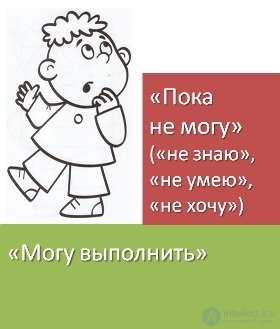
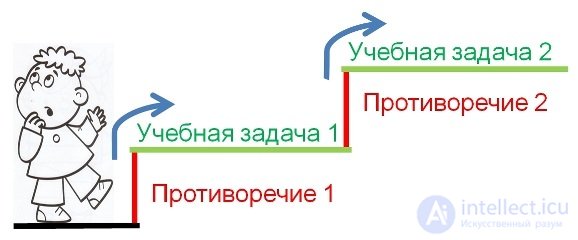
Fig. 4.2. Personality overcoming the contradictions of the educational process
Contradiction becomes the driving force of learning if ...
a) it is understood by the student as requiring permission;
b) the resolution of contradiction is feasible for a student of this level of development;
c) this contradiction is a legitimate link in the system of contradictions requiring gradual resolution.
The logic of the educational process reflects the path of knowledge, which the student goes through in the process of learning. The logic of the educational process depends on the age and level of preparedness of students, on the characteristics of the material being studied, on the goals and objectives of the educational process. For example, in elementary school, the traditional logic of learning prevails: the perception of specific objects and phenomena → the formation of representations → the generalization of individual representations → the formation of general concepts. In middle and high schools, almost simultaneously with the perception of specific objects and phenomena, scientific concepts can be introduced, principles explained.
The structure of the educational process is the construction of the learning process, the unity, interconnection and interaction of its individual components (I. F. Kharlamov):
- target (goals and objectives of the education, upbringing and development of students);
- motivational need (motives of teaching and learning, the need for the transfer and perception of knowledge and experience);
- meaningful (education content);
- activity-operational (educational technologies);
- emotional-volitional (cognitive interests and responsibility in the educational process);
- control and adjustment (monitoring the course of the educational process, its correction);
- Estimated performance (objective assessment of learning outcomes based on a comparison of the result with the target component).
To the top
Learning functions
The main functions of learning: educational, educational, developmental. These functions are historically entrenched in the learning process, their implementation ensures the full development and successful socialization of the students' personality.
The educational function is to build knowledge, skills, abilities, experience of creative activity.
The educational function is associated with the formation of students' morality, aesthetic ideas and tastes, the system of world views, the ability to follow social norms of behavior.
The developmental function is that in the process of learning a child develops in all directions: his speech, thinking, emotional-volitional, motivational-needy and sensory-motor spheres of the personality develop.
The problem of unity and interrelation of learning functions is that in order for a student to form a basic culture of personality, for his harmonious development, the learning process must be carried out in such a way that its functions are inseparable, implemented in all components of learning: in the complex of lesson tasks, in the content of learning material in the system of methods, techniques, forms and means of training, etc.
To the top
Patterns of the learning process
Learning theory, like any science, seeks to cognize and formulate general laws that govern the processes, objects and phenomena that it studies. However, the pedagogical process is too complex, subject to the influence of many factors, including those that cannot be considered in advance. This makes a clear and unconditional formulation of the laws of learning impossible, at least in the present.
Laws of learning are insufficiently known laws, orderliness of known phenomena arising from the learning of relationships and dependencies, as well as factors affecting the didactic process.
There are many approaches to the allocation of learning patterns.
So, Yu.K. Babansky identified patterns as a series of learning dependencies:
1) from the needs of society;
2) on the processes of education, upbringing and development as parties to the holistic pedagogical process;
3) on student opportunities and external conditions.
I.P. Podlasyy identifies in the structure of learning patterns general (expressing the dependence of the learning process on its goals, content, teaching methods, nature of managing the learning process, etc.) and specific patterns (didactic or substantive-procedural, psychological, organizational, etc.).
N.V. Bordovskaya and A.A. Rean subdivides the patterns of learning into external (manifested as dependencies of learning on social conditions) and internal (links and dependencies between the components of the didactic process: goals, educational content, methods, means and forms of learning, between teacher and student).
Examples of specific learning patterns:
- the more active the child is in the educational process, the higher the learning outcome;
- if the teacher is available for children to present new material, then they will understand it better;
- the more sense organs are involved in the perception of educational material, the better it is perceived and remembered;
- if you repeatedly repeat some action, then it can be performed without thinking, automatically;
- no matter how well the learning material is learned, it is still forgotten if it is not repeated periodically, etc.
To the top
Principles of learning
Principles of learning are fundamental provisions that reflect the general requirements for the organization of the educational process. The principles are formulated on the basis of a scientific analysis of the learning process, correlate with its laws, with the goals and objectives of education, with the level of development of pedagogical science, with the capabilities of the existing education system.
Today there is no consensus on the principles of learning, the authors of various textbooks offer different formulations and a different number of principles. So, I.P. Podlasy believes that the system of basic didactic principles should include the following principles: 1) consciousness and activity; 2) visibility; 3) consistency and systematicity; 4) strength; 5) availability; 6) science; 7) the connection of theory with practice. P.I. Pidkasisty and V.V. Ravens add to them the principle of developing and educating the nature of training and the principle of a rational combination of collective and individual forms of educational work.
However, with all the variety of existing approaches, a number of principles can be identified that have passed a long test of time and are present - one way or another - in the vast majority of modern textbooks and manuals on pedagogy. Consider these principles.
The principle of science focuses the teacher on the formation of students' scientific knowledge. It is implemented in the analysis of educational material, the allocation of important ideas in it, the use of reliable scientific knowledge, facts and examples, as well as standard scientific terms. The implementation of this principle requires a teacher ...
- correct students' factual errors and organize the search and correction of such errors in the classroom;
- apply the latest scientific terminology, do not use outdated terms;
- be aware of the latest scientific achievements in your subject;
- to encourage research work of students;
- find the opportunity to acquaint schoolchildren with the technique of experimental work, the algorithm for solving inventive problems, the use of reference materials, archival documents, with the processing of primary sources.
The principle of consistency determines the need for students to form an integrated system of knowledge and skills, topics and sections of educational material. The principle of consistency is implemented in a set of rules, among which are the following:
- use plans, charts in order to ensure students learn the system of knowledge;
- divide the content of educational material into logical completed parts (ie, apply a “step-by-step system”), consistently implement these parts (steps, steps) and accustom students to this;
- not to allow the system to be disturbed in the content and methods of training, and if it is violated, then immediately neutralize the gaps in order to prevent academic failure;- state the basis of the theory, explain the consequences of the theory and show the limits of its application.
The principle of accessibility (feasibility) is a reflection of the principles of consistency and gradual learning, which have been known since antiquity.
Perhaps one of the most convincing examples of the implementation of these principles is the history of the invincible ancient wrestler Milo, who lived in the 4th century BC. In his youth, Milon trained by carrying a small calf on his shoulders daily. The calf grew, gradually becoming heavier. However, the young man at this time developed physically, and still could wear it on himself.
The essence of the principle of accessibility is that you first need to identify early formed knowledge and skills, and only then gradually implement new stages of learning. The principle of accessibility does not mean that the teaching should occur without effort on the part of the student, but overcoming the difficulties that arise should be feasible for him. To comply with this principle, you must follow a number of rules:
- to achieve the coincidence of the rate of communication of information and the speed of its assimilation by students;
- to focus students on understanding and understanding the material being studied, and not on memorization and cramming;
- teaching, to proceed from the level of preparedness of students, to rely on their capabilities;
- study and take into account life experience, interests, features of the development of students, etc.
The principle of clarity is not only to illustrate the subject and phenomenon being studied, but to use a whole range of techniques and tools that ensure the formation of a clear and precise perception of the knowledge communicated by the teacher. Here are some of the rules for effectively implementing the visibility principle:
- use a pattern in teaching that storing objects clearly presented (for example, on models or pictures) is better than if they are described only in verbal form;
- using the means of visualization, not to get involved in an excessive number of visual aids;
- when using visual aids, not only to show them, but to explain and comment on visual material;
- carefully prepare the types of clarity to the application, thinking through their accompanying didactic techniques;
- in the selection of means of visibility to take into account the age characteristics of students.
The principle of consciousness and activity is aimed at developing students' learning motivation, cognitive needs, and conviction in the need to study the material and interest in the teaching. The essence of the principle is that the teacher should strive for understanding (and not mechanical memorization) by students of theoretical material and comprehension of practical actions, encourage them to active learning activities, to stimulate independence in cognition. As recommendations for the practical application of this principle, the following rules can be given:
- use the possibilities of mutual learning;
- organize competition and student partnerships;
- provide conditions for the collective search for the correct answer;
- enter into the educational process entertaining tasks, game elements;
- learn to find the secondary and the main thing in the material under study;
- use real life situations in teaching and demand from students an independent understanding, a vision of the differences between the facts observed in life and their scientific explanation.
To the top
Modern didactic concepts
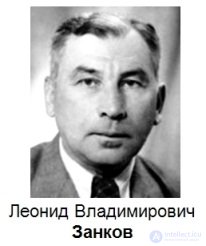
A distinctive feature of modern didactic concepts is their developing character, a new, active-activity way of learning. Consider some concepts of developmental learning.
Concept lv Zankova. The efforts of the research team under the leadership of L.V. Zankova in the 1950s – 1960s were aimed at developing a new, more effective system of teaching younger students. The basis of this concept is the following interrelated principles:
- learning at a high level of difficulty;
- fast paced learning program material;
- leading role of theoretical knowledge;
- the student’s awareness of the learning process;
- purposeful and systematic work on the development of all students, including the weakest.
These principles were implemented in specially developed programs and methods of teaching reading, writing, mathematics, environmental studies and other subjects. Learning System L.V. Zankova showed high efficiency in experimental testing, but the attempt to introduce it into mass practice, undertaken in the 1960s – 1970s, failed because the vast majority of teachers at that time were unable to master it. The revival of this concept in the late 1980s - early 1990s. caused by the orientation of the school to student-centered learning.
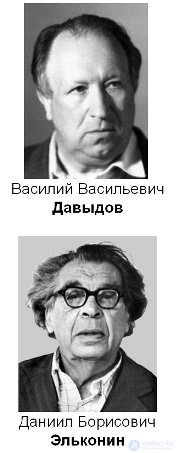
The concept of meaningful learning was developed in the 1960s. the research team under the guidance of psychologists V.V. Davydova and D.B. Elkonin also for elementary school. According to this concept, a schoolchild in the process of mastering educational material moves from understanding a concrete image to understanding an abstract concept. The subsequent theoretical reproduction is based on the reverse logic: the thought of the student moves from the abstract to the concrete. It is this logic of building the educational process that should contribute to the best learning outcomes of younger students.
The concept of a phased formation of mental actions was developed on the basis of the corresponding theory of P.Ya. Halperin and N.F. Talyzina. The following pattern underlies this theory: every mental action originates from a material, from an external action. To form any mental skill, you must first create training conditions that simulate it in the form of actions with objects and other material objects, and then transfer its implementation to the verbal (verbal) level.
According to the concept of a phased formation of mental actions, the possibilities of the learning process increase significantly if, in the process of learning, children learn through the following interrelated stages:
1) the motivation of activities and the preliminary familiarization of students with the action and the condition for its implementation;
2) students' awareness of the scheme, the algorithm of the upcoming action (at this stage, schemes, instructions, memos that clearly represent the individual operations and their sequence are widely used);
3) external execution of the action and pronouncing the action out loud;
4) generalization of the action (usually it is a statement expressed aloud, summing up the action performed);
5) the stage of internal speech, the translation of the action from the external form (material) into the internal, mental;
6) the consolidation of action in the internal, mental plane, the awareness of it as a personally significant, necessary.
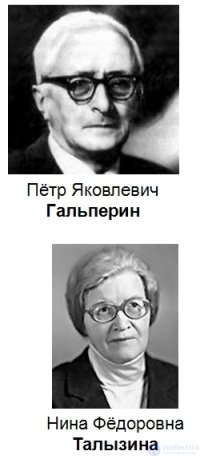
The concept of problem-based learning involves the search for reserves for the mental development of students: the ability for creative thinking and independent cognitive activity. The scientific substantiation of this concept was made in the 1960–1970s. works t.v. Kudryavtseva, A.M. Matyushkina, MI Makhmutova, V. Okony and others.
The essence of problem-based learning is to organize the teacher for students of problem situations, the awareness of these situations, their adoption and decision in the process of joint interaction of students and the teacher with the maximum independence of students and the general guidebook teacher.
Problem situations arise, for example, in such cases:
- if there is a discrepancy between facts already known to the student and new knowledge;
- if students are faced with new conditions for them to use the already existing knowledge and skills;
- if it is necessary to choose from the methods of solving the learning and cognitive task known to the student, the only correct or best, etc.
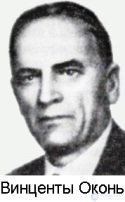
When creating problem situations, the teacher should follow the rules :
- Each task must be based on the knowledge and skills that the student already owns;
- that unknown, which needs to be “discovered” by the pupil in resolving a problem situation, must be learned, contribute to the formation of really important knowledge and skills;
- the performance of a problem assignment should arouse an interest in the student, a need for assimilable knowledge.
In problem-based learning, it is customary to distinguish four main stages :
1) awareness of the problem situation (“the situation requires resolution, because ...”);
2) analysis of the situation and the formulation of the problem (“the problem is that ...”);
3) problem solving: hypothesizing and justifying solutions, selection of the most logical hypotheses and their consistent testing;
4) verification of the correctness of the decision ("the contradiction is eliminated, because ...").
To the top
Educational content
The question of what to teach is one of the most important in didactics. In different historical eras, eminent thinkers, public figures and teachers tried to answer him. As a result, by the beginning of the XIX century. two general scientific theories were formed, reflecting two main views on the essence of this issue: the theory of didactic encyclopedism (the theory of the material content of education) and didactic formalism (the theory of the formal content of education).
The essence of the didactic encyclopedic is that the child must form a system of scientific knowledge, and the wider it covers various sciences, the deeper the knowledge, the better. Among the famous adherents of this point of view is the ancient philosopher Socrates, an English thinker of the XVI-XVII centuries. Francis Bacon and the founder of scientific pedagogy, Jan Amos Comenius.
In didactic formalism, the main value is not knowledge in and of itself, but methods of action, the ability to use knowledge in practice and to find it independently. In ancient times, this idea was formulated by Heraclitus ("Multi-knowledge does not teach the mind"). This theory was held by such outstanding teachers of the past as John Locke, Johann Heinrich Pestalozzi, Johann Herbart.
Both theories have their strengths and weaknesses: didactic encyclopedism well forms theoretical knowledge, but does not sufficiently link the learning to life, and didactic formalism equips with practical skills, but limits the development of theoretical thinking. Therefore, there is a third point of view, which in the second half of the nineteenth century. expressed Russian teacher KD. Ushinsky: it is necessary to unite the achievements of both theories, finding the “middle ground” in the ratio of the knowledge and experience of the activity generated by the individual.
In the late XIX - early XX century. a theory of didactic pragmatism (didactic utilitarianism) is being created, at the root of which are John Dewey and Georg Kerschensteiner. According to this theory, the content of education should be formed on an interdisciplinary basis, meet the requirements of practical benefits, as well as the interests and inclinations of the child. Proponents of this theory seek to diversify the content of education as much as possible, but do not require its development by all students. Diversity is necessary so that the child (or his parents, persons replacing them) can choose what will most contribute to his self-realization in life. Accounting for individual characteristics is an important advantage of this theory. However, it also has disadvantages:
- in case of mass education, it is much more difficult to ensure its implementation than the implementation of previous theories;
- the variety of possible educational content makes it difficult for a child or his family to make the right choice, which often leads to a decrease in the quality of learning outcomes.
In the XX century. there are new theories of formation of the content of education. Thus, the Polish scientist-teacher Vincent Okon developed the theory of functional materialism . In his opinion, the content of education in any academic discipline should be formed on the basis of a certain leading idea, reflecting the specifics of this discipline, the features of its functions in the integral system of formation of a scientific outlook in a child. For example, in biology, such an idea would be the idea of evolution, in history - historical conditionality of sociocultural phenomena, etc. Thus, each academic subject acquires a single core, allowing to combine the requirements of society and the individual educational needs of students.
Another of the relatively new theories (mid-20th century) is the theory of operational structuring of the content of education. In this theory, attention is paid not so much to the content of education itself, but to ways of structuring it: the unity of its parts and the connections between these parts. The structure of the content of education is a very important aspect, since it depends on how the student learns the system of knowledge and experience in the content of education, how convenient this system will be for later practical use.
So, the question “What to learn?” Is answered by the content of education.
The content of education is a pedagogically adapted system of knowledge, skills and abilities, experience of creative activity and emotional-volitional relations, the assimilation of which should ensure the formation of a comprehensively developed personality ready to preserve and develop the material and spiritual culture of society (I.Ya. Lerner, MN Skatkin).
In other words, the content of education is what a student must master as a result of training.
The content of education has not remained unchanged over the centuries, it continues to change now. The content of education reflects the social ideal: the ideas that exist in society about what an educated person should be. The content of education depends on the socio-economic and socio-cultural conditions, on the level of development of the education system, on the degree of its control by the state, etc.
The content of education is influenced by two main groups of factors:
1) the goal of education, expressing the needs of society (briefly, social needs can be formulated as the formation of a person who is necessary and useful to society);
2) features of a person as a participant in the educational process, patterns of his psychophysical development.
The source of the content of education is the experience of mankind, enshrined in material and spiritual culture. However, the experience gained by people is so huge that it is impossible to transfer it to the new generation in full. And this is not required, because many special knowledge will never be useful in the lives of most people, they will be needed only by professionals. But how to choose from the vast heritage of human culture exactly what is needed by all or the absolute majority of secondary school graduates - what will become the basis for further successful education and personal development? This is the main problem of the selection of educational content .
V.V. Krajewski justified the following principles for the selection of educational content :
- compliance of the content of education with the requirements of society, science, culture and personality;
- the unity of the substantive and procedural aspects of education (i.e., the content of education must be selected taking into account the characteristics of the pedagogical process);
- the structural unity of the content of education at different levels of its formation: scientific theory, curriculum, educational material, pedagogical activity, student's personality, etc .;
- humanitarization - focus on the person, on creativity and assimilation of human culture (this principle implies the practical significance of the knowledge and experience gained for people);
- fundamentalization - the creation of a “foundation” of a self-developing personality (the union of sciences and the arts, the transfer of knowledge and skills to other sciences and arts, the formation of general educational skills, skills of self-education).
To the top
Different approaches to the design of educational content for students of different levels of education
In the development of the main components of the content of education in the period from the 1990s to the present, there are two main approaches: knowledge and competence.
According to the knowledge-based approach , the basis of the content of education is knowledge generated in the educational process, and the following components are distinguished in the structure of the content of education:
knowledge - theoretical information reflecting the systematized and generalized experience accumulated by mankind;
the skills and abilities to apply knowledge in practice of ready-made algorithms in standard situations (skills - possession of a meaningful action performed under the control of consciousness; skills - actions brought to automatism);
experience of creative activity - the ability of an individual to apply acquired knowledge, skills and abilities (skills) in new situations for themselves, the algorithm of actions in which is not known in advance;
experience of relations to different sides of the world, to himself, formed as a result of understanding and emotional experience of the knowledge and experience acquired by an individual.
With the competence approach, the basis of the content of education is competence - the skills and abilities of the individual to successfully solve certain tasks in educational activities in the personal and social sphere. Competences formed in the educational process are numerous, they relate to the types of human activity, to different spheres of social interaction.
At present, the following competence structure is the basis for designing the content of general education:
personal competence;
metasubject competencies;
subject competence.
The content of these competences blocks is disclosed in the Federal State Educational Standards of General Education.
At the beginning of the XXI century. the competence approach to the design of the content of education at all its stages becomes prevailing.
Designing the content of education for students of different levels of education is based on the idea of the age-specificity of the pedagogical process (the essence of the age-specificity is disclosed in the topic “The holistic pedagogical process”).
The elementary school level corresponds to primary school age. At this age, the regulation of the behavior of schoolchildren comes to the fore. The teacher influences children through their inclusion in the sphere of their vital activity. The factor of successful inclusion is the authority of the teacher: the student of the lower grades learns the new position of the student, and the teacher is a model for him. In the system of motivation for teaching in primary school, the first place is occupied by a sense of duty to the teacher, the desire to fulfill his requirements. At this stage, the teacher performs dialogue dialogue mainly in the form of direct subjective requirements (indication, prohibition), indirect requirements (advice), as well as through a system of objective requirements (norms and rules).
The primary school level (grades 5-9) corresponds to adolescence. The features of this age are associated with the emergence of a new level of self-consciousness, which psychologists have conventionally called the “sense of adulthood”, which is expressed in the desire to be and be considered an adult. This is a completely different position in relation to the world around and to oneself. If the views of the younger student about themselves were adjusted to the opinions of adults about him, and the relationship was built on the child’s subordination to the adult, then for adolescent students such relations are unacceptable. In working with teenage students, the pedagogical impact through information and stimulation is most effective. In the system of relationships between a teenager and those around him, peers play a special role as more or less equal partners in communication. The subject of an active emotional attitude of adolescents are the events of collective life.
The grade of full (middle) school corresponds to the senior school age. In the upper grades, the contradictions inherent in adolescence are somewhat mitigated (but do not disappear completely), and in most cases mutual understanding and equal relations with others, with teachers and parents are established. At the forefront is the awareness of their actual life position, their own capabilities, as well as intentions and aspirations. The senior student is notable for moralizing, so the teacher needs to combine information with instruction, which is no longer a direct requirement, but an authorization (approval of the decision made by the student).
To the top
State educational standards
The state educational standard is a system of basic parameters taken as the state norm of education, reflecting the social ideal and taking into account the capabilities of the individual and the education system to achieve this ideal (V.S. Lednev).
The legal basis for state standardization of education is contained in the Constitution of the Russian Federation , according to which the Russian Federation establishes federal state educational standards (Art. 43.5), as well as in the Law of the Russian Federation “On Education” (adopted in 1992, losing its force on September 1, 2013) and the new Federal The Law "On Education in the Russian Federation" (2012) , which comes into effect on 01.09.2013.
The main reasons for the state standardization of educational content :
- it is necessary to ensure a uniform minimum level of education obtained in different types of educational institutions in Russia;
- it is necessary to take into account the trends in the development of education in the world (on the scale of an entire country it is more rational to do this centrally.
The state educational standard performs a number of important functions , among which there are:
- the function of social regulation is to ensure the equivalence of education in all educational institutions of the same level (for example, the minimum level of education for a graduate of a basic school is the same, regardless of whether he studied in a village or city, in a regular school or in a gymnasium);
- the function of humanizing education is associated with the assertion of its personality-developing essence with the help of standards: the educational standard regulates only the minimum educational level, the education that is higher than this level can differentiate depending on the characteristics, needs, abilities of the students' personality;
- the management function is that the standardization of educational content allows you to streamline educational systems, use uniform criteria for the quality of education, unify grades, etc .;
- the function of improving the quality of education is carried out on a national scale due to the possibility of establishing a lower limit of the level of education and constant modernization of the educational standard in order to raise the minimum educational level.
The basis of the new Federal state standards of general education is a system-activity approach , which implies:
- fostering and developing personality traits that meet the requirements of an information society, an innovative economy, the tasks of building a democratic civil society based on tolerance, dialogue of cultures and respect for the multi-ethnic, multicultural and multi-confessional composition of Russian society;
- transition to the strategy of social design and design in the education system based on the development of educational content and technologies that determine the ways and means of achieving the socially desirable level (result) of the personal and cognitive development of students;
- orientation to the results of education as a system-forming component of the Standard, where the development of the personality of a student on the basis of mastering universal educational actions, knowledge and mastering the world is the goal and the main result of education;
- recognition of the decisive role of educational content, ways of organizing educational activities and the interaction of participants in the educational process in achieving the goals of personal, social and cognitive development of students;
- taking into account the individual age, psychological and physiological characteristics of students, the role and importance of activities and forms of communication to determine the goals of education and training and ways to achieve them;
- ensuring the continuity of pre-school, primary general, basic and secondary (full) general education;
- a variety of organizational forms and taking into account the individual characteristics of each student (including gifted children and children with disabilities), ensuring the growth of creative potential, cognitive motives, enrichment of forms of interaction with peers and adults in cognitive activity;
- guaranteeing the achievement of the planned results of mastering the basic educational program of primary general education, which creates the basis for the students to successfully master the new knowledge, skills, competencies, types and ways of activity.
According to the requirements for the results of mastering basic educational programs at all levels of general education, there are three main blocks (components) of the content of education: personal, metasubject and subject.
The personality component includes ...
- readiness and ability for self-development and personal self-determination;
- the formation of motivation to learn and targeted cognitive activity;
- the existence of a system of value relations reflecting personal and civic position in activities, social competences, legal consciousness;
- the ability to set goals and build life plans;
- ability to recognize Russian identity in a multicultural society.
Meta-subject component suggests ...
- possession of interdisciplinary concepts;
- the ability to use in educational, cognitive and social practice universal educational activities (regulatory, cognitive, communicative);
- independence of planning and implementation of educational activities and organization of educational cooperation with teachers and peers;
- способность к построению индивидуальной образовательной траектории.
В предметный компонент входят…
- умения, специфические для данной предметной области;
- виды деятельности по получению, преобразованию и применению нового знания в рамках учебного предмета в учебных, учебно-проектных и социально-проектных ситуациях;
- научный тип мышления, научные представления о ключевых теориях, типах и видах отношений;
- владение научной терминологией, ключевыми понятиями, методами и приёмами.
Федеральные государственные образовательные стандарты (ФГОС) общего образования, действующие в России на сегодняшний день – это основные документы, регламентирующие содержание общего образования для каждой его ступени. Отдельные ФГОС разработаны для начального, основного, полного (среднего) общего образования, и каждый из них утверждён отдельным приказом Министерства образования и науки Российской Федерации.
Вместе с тем, все ФГОС преемственны, любой из них имеет следующую структуру .
I. Общие положения.
Ii. Требования к результатам освоения основной образовательной программы.
Личностные результаты освоения основной образовательной программы.
Метапредметные результаты освоения основной образовательной программы .
Предметные результаты освоения основной образовательной программы.
Iii. Requirements for the structure of the main educational program.
Iv. Requirements for the implementation of the main educational program.
To the top
A Document regulating the content of the general education
Documents regulating the content of education are the federal state educational educational standards, curricula, curricula, textbooks.
The curriculum records the recommended composition of school subjects and the distribution of study time between them. It has the form of a table, in which for each school subject the number of lessons per week for each year of study is indicated. There are three main types of curricula:
- basic school curriculum (BUP) - the main regulatory document;
- типовые учебные планы – варианты БУПа, утверждённые Министерством образования или региональным управлением образования (для национально-регионального компонента) и рекомендуемые в качестве основы планирования для школ;
- учебный план образовательного учреждения – учебный план, по которому работает конкретная школа, составленный на основе одного из типовых планов с соблюдением нормативов БУПа.
Учебная (образовательная) программа - нормативный документ, в котором определяется круг основных знаний, умений и навыков, подлежащих усвоению по
продолжение следует...
Часть 1 Learning theory
Часть 2 - Learning theory
Часть 3 - Learning theory
Comments
To leave a comment
Pedagogy and didactics
Terms: Pedagogy and didactics